

Uh, oh. New study shows Earth's internal heat drives rapid ice flow and subglacial melting in Greenland – Watts Up With That? Distant history of the North Atlantic region contributes to the present-day ice loss From the GFZ German Research Centre for Geosciences To understand Greenland’s ice of today researchers have to go far back into Earth’s history.
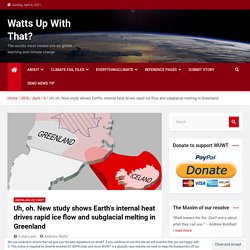
The island’s lithosphere has hot depths which originate in its distant geological past and cause Greenland’s ice to rapidly flow and melt from below. Newly discovered Greenland (mantle) plume drives thermal activities in the Arctic. Research News.
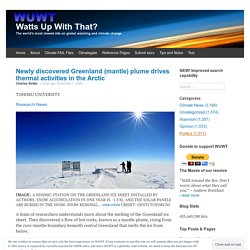
Scientist Spots High Geothermal Heat Flux In East Greenland – ‘Dramatic Consequences For Ice Basal Melting’ By Kenneth Richard on 5.

July 2019 Geothermal heat flux can foment upper mantle temperature anomalies of 800–1000 °C, and these extreme heat intensities have been found to stretch across 500 km of central-east Greenland. This could result in “a significant contribution of ice melt to the ice-drainage system of Greenland” (Artemieva et al., 2019). Evidence of more than 100,000 formerly or currently active volcanic vents permeate the Earth’s sea floor (Kelley, 2017).
Active volcanoes spew 380°C sulfuric acid and “metal-laden acidic fluids” into the bottom waters of the world ocean on a daily basis. The carbon dioxide concentrations present in these acidic floods reach “astounding” levels, dwarfing the potential for us to even begin to appreciate the impact this explosive geothermal activity has on the Earth’s carbon cycle (Kelley, 2017). Image Source: Kelley, 2017. Numerous Studies Confirm Geothermal Heat Melting Greenland Ice Sheet. Published on July 26, 2019 Written by James Edward Kamis Figure 1.)

Greenland Ice Disappearing Due to Earth’s Mantle Claims Study – Guardian Liberty Voice. Greenland ice sheets are beginning to melt at a dangerous rate, with great concern expressed amongst the scientific community over human-induced, climatic temperature changes.

A band of global researchers claim their new study, written in Nature Geoscience, is the first to identify evidence that links the disappearance of Greenland’s ice sheets and heat generated from the Earth’s mantle. The multinational research team have developed the IceGeoHeat project, headed by the GFZ German Research Centre for Geosciences. According to the GFZ website, this initiative aims to measure the patterns of geothermal heat, in areas that are predominantly enveloped by broad stretches of ice. Greenland Ice Melt Geothermal, Not Man-made — Plate climatology. Newly released research, primarily from NASA and the GFZ German Research Center for Geosciences, indicates that melting of selective Greenland Glaciers is related to geologically induced heat flow, and not manmade atmospheric global warming.
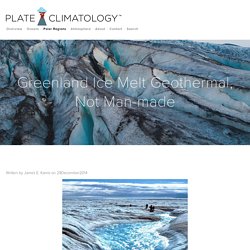
Previous articles posted here and here have documented the effect of geologically induced geothermal heat flow on the West Antarctic continent and Arctic Ocean Ice Sheets. In both cases relatively recent research was used to show natural variations in climate, climate-related events, and warmed from geothermal heat. You can learn more about plate climatology and global warming here. How Geologic Forces are Melting Southern Greenland Ice Sheet — Plate climatology. Proof supporting this phenomenon is compelling and reliable, because it’s happened before.
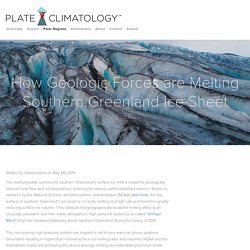
The well-documented 2009-2010 southern Greenland Ocean “warm cell” (Figure 2) occurred for the same length of time, had a limited geographical location, and persisted as long as the 2009-2010 southern Greenland surface ice melting. Secondly, the ongoing 2016 surface ice melting, or the southern Greenland Omega Block, is also associated with a rapidly building southern Greenland Ocean warm cell as per shallow sea surface (SST) anomaly maps. This latest Omega Block, or high-pressure system, is occurring in the same exact limited geographical location as the 2009-2010 event. The awesome power and far-reaching influence of the 2009-2010 southern Greenland Ocean warm cell is famous for another reason, it caused the 2010 Gulf Stream “Shutdown” as described in a previous Climate Change Dispatch article (here). The media is culpable as well. New Findings Show Greenland Ice Changes, Melt Water Production Due To Natural Geothermal Factors! By Kenneth Richard According to a just-published (2016) Nature scientific paper, large portions of the Greenland Ice Sheet (GIS) are significantly melting from below due to massive geothermal heat flux forcing.
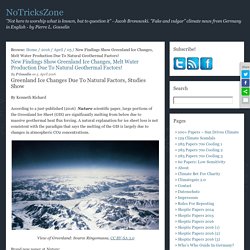
A natural explanation for ice sheet loss is not consistent with the paradigm that says the melting of the GIS is largely due to changes in atmospheric CO2 concentrations. View of Greenland: Source Ringomassa, CC BY-SA 3.0 Brand new paper at Nature: Melting at the base of the Greenland ice sheet explained by Iceland hotspot history. Machine learning predicts new details of geothermal heat flux beneath the Greenland Ice Sheet. A paper appearing in Geophysical Research Letters uses machine learning to craft an improved model for understanding geothermal heat flux—heat emanating from the Earth's interior—below the Greenland Ice Sheet.
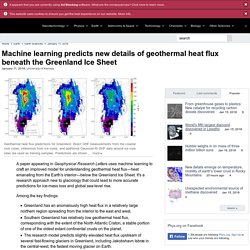
It's a research approach new to glaciology that could lead to more accurate predictions for ice-mass loss and global sea-level rise. Groundbreaking AGW-Undermining Study: Greenland’s Warming, Ice Loss Due To Geothermal Heat. ‘Several Thousand’ Hot (60°C) Springs ‘All Over’ Greenland Melt The Ice Sheet From Bottom Up A few years ago, 10 glaciologists publishing in the journal Nature Geoscience asserted that “large parts of the north-central Greenland ice sheet are melting from below” due to high geothermal heat flux forcing (Rogozhina et al., 2016).

In a new paper published in Scientific Reports, 4 more glaciologists (Rysgaard et al., 2018) report that “hot vents” (or hot springs) of geothermally-heated water underneath the Greenland ice sheet can explain localized rising temperatures and glacial melting. Water Temperatures Beneath Greenland Reach 55-62°C (Water Boils At 100°C) Water temperatures of these natural hot springs reach into the 60°C (140°F) range, and there are “several thousands“ of them “all over Greenland“, with observations of high geothermal heat/ice-melt locations spanning the East, West, North, South, and Central regions of this glaciated island.
Greenland May Be Rife With Geothermal Activity. Earth's internal heat drives rapid ice flow and subglacial melting in Greenland. Heat loss from Earth's interior triggers ice sheet slide towards the sea. Greenland's ice sheet is becoming smaller and smaller. The melting takes place with increased strength and at a speed that no models have previously predicted. Today, in the journal Scientific Reports, researchers from the Arctic Research Centre, Aarhus University, and the Greenland Institute of Natural Resources present results that, for the first time, show that the deep bottom water of the north-eastern Greenland fjords is being warmed up by heat gradually lost from the Earth's interior.